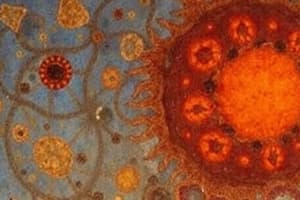Podcast
Questions and Answers
What is the main difference between eukaryotic cells and prokaryotic cells?
What is the main difference between eukaryotic cells and prokaryotic cells?
- Eukaryotic cells lack a cell membrane, while prokaryotic cells have a cell wall.
- Eukaryotic cells have flagella for movement, while prokaryotic cells have cilia.
- Eukaryotic cells have a nucleus and organelles, while prokaryotic cells lack a nucleus and membrane-enclosed organelles. (correct)
- Eukaryotic cells store materials in vacuoles, while prokaryotic cells break down cell debris in lysosomes.
Which organelle is responsible for synthesizing proteins in a cell?
Which organelle is responsible for synthesizing proteins in a cell?
- Lysosomes
- Mitochondria
- Golgi apparatus
- Endoplasmic reticulum (correct)
What unique structures do plant cells have that animal cells lack?
What unique structures do plant cells have that animal cells lack?
- Mitochondria
- Ribosomes
- Nucleus
- Chloroplasts and cell wall (correct)
Which cell part is responsible for breaking down cell debris?
Which cell part is responsible for breaking down cell debris?
What is the function of cilia in some cells?
What is the function of cilia in some cells?
Which type of cells produce energy in an organism?
Which type of cells produce energy in an organism?
Flashcards are hidden until you start studying
Study Notes
- Cells are the smallest living units of an organism and all cells share common features like a cell membrane, cytoplasm, and DNA.
- There are two main categories of cells: eukaryotic cells (more advanced with a nucleus and organelles) and prokaryotic cells (simpler, without a nucleus or membrane-enclosed organelles).
- Organelles are specialized cell parts with unique functions, such as the nucleus (containing DNA and nucleolus), ribosomes (synthesize proteins), endoplasmic reticulum (transport materials), Golgi apparatus (modify proteins), vacuoles (store materials), lysosomes (break down cell debris), mitochondria (produce energy), and cytoskeleton (maintains cell shape).
- Plant cells have chloroplasts for photosynthesis and a cell wall for support, while animal cells lack a cell wall.
- Some cells have unique structures like cilia (respiratory tract cells with hair-like projections) and flagella (some bacteria and sperm cells with tail for movement).
Studying That Suits You
Use AI to generate personalized quizzes and flashcards to suit your learning preferences.




